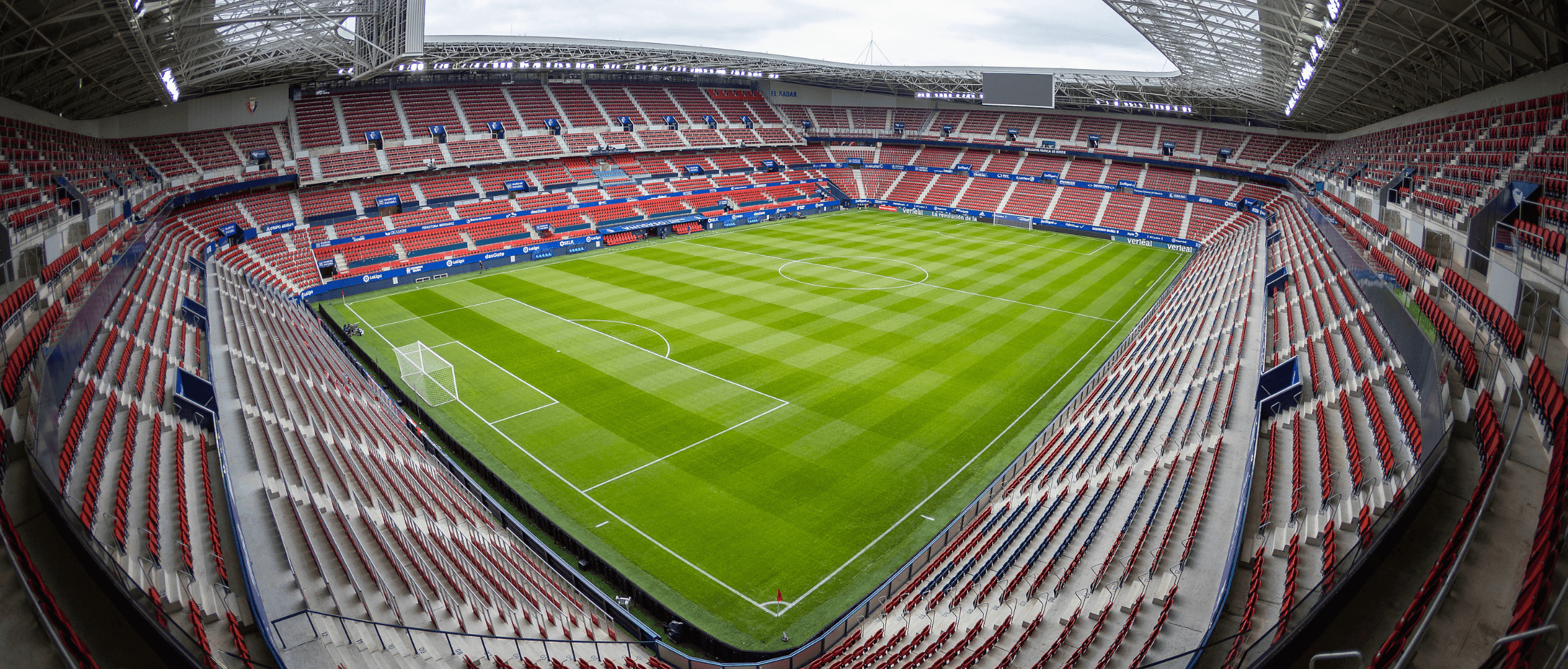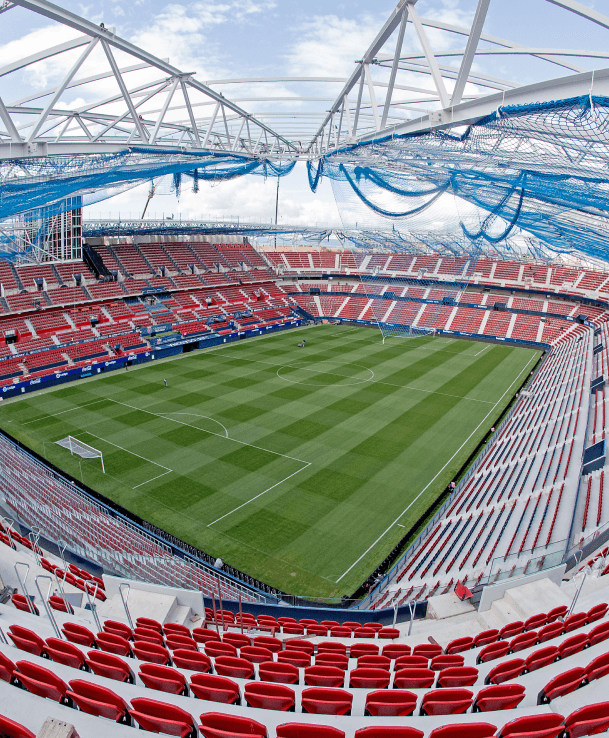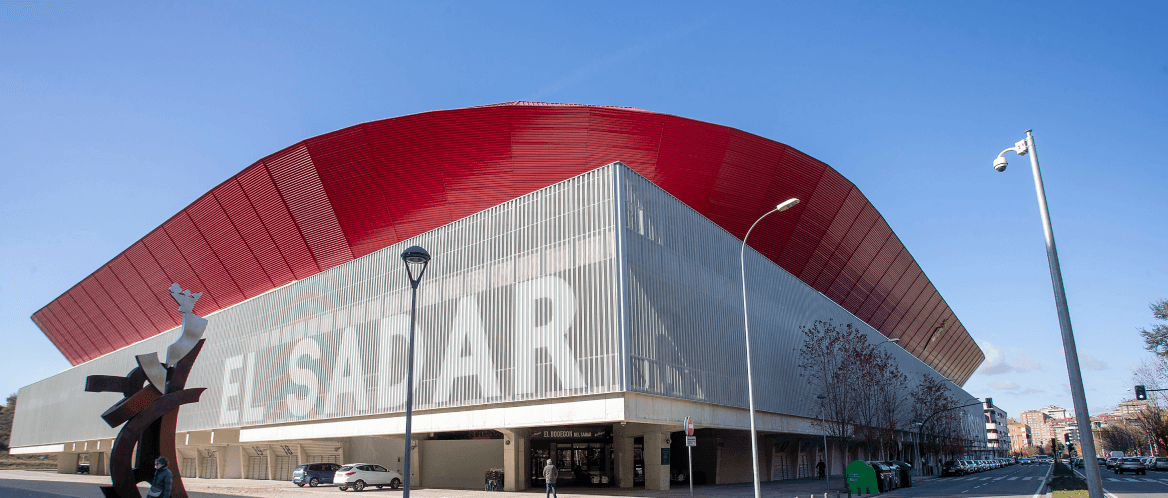
THE REFORM OF EL SADAR
A UNIQUE PROCESS IN THE WORLD OF FOOTBALL
For over half a century, El Sadar has become the temple and heart of osasunismo. However, the passage of time had revealed some insurmountable deficiencies in the facility. Club Atlético Osasuna's stadium did not have an activity license, and to obtain it, it required a thorough refurbishment to enable the stadium to comply with current legislation on safety. Likewise, the entity also found itself obligated to install new lighting, required by LaLiga to comply with television requirements, which made it necessary to replace the old roof, which could not support the weight of the new lighting needed and its working walkways.
Faced with the obligation to undertake refurbishment that required the Club to invest 8.5 million euros (to which had to be added a refund to the Treasury of 1.5 million due to not reaching the total committed expenditure of 15 million in renovations before 2020), the board of directors proposed to its members the possibility of carrying out a comprehensive refurbishment that would increase the capacity of a stadium that had become too small and improve the amenities to enhance the fans' experience at El Sadar. At a press conference held on July 4, 2018, Club president Luis Sabalza announced that the reform of El Sadar would be carried out through an open and participatory process. For the first time in the history of professional football, the football club members would decide how their stadium would be for the coming decades.
On the one hand, the members would decide whether to opt for a basic or a comprehensive renovation. On the other hand, they would decide which complete renovation project they would opt for in case the members chose this type of renovation as the majority choice. On the same day, the Club published the terms and conditions of an architectural competition to present integral renovation projects. The most noteworthy feature of the competition was that the proposed reforms were required to be carried out under the turnkey modality and with a guarantee from a construction company that could not exceed a ceiling of 16 million euros. Five projects were submitted to the bid, and all of them passed the cut of a technical committee that supervised the process, made up of independent professionals with an excellent reputation in the field and technicians from the Government of Navarre and the Pamplona City Council.
At the same time, Club Atlético Osasuna ensured that the members had the maximum information about the process within their reach. Firstly, an exclusive web page was launched for the refurbishment of El Sadar, where, in addition to finding information about the projects, a mailbox was also set up for members to leave suggestions that were subsequently passed on to the architectural firms. Likewise, throughout the process, the Club provided members with dossiers and detailed information sent to their e-mail addresses.

75% OF THE MEMBERS VOTED IN THE REFERENDUM ON THE STADIUM
The five comprehensive reform projects were presented on October 24, 2018, at a gala at the Museum of the University of Navarra, to which the club's members were invited. Both the five integral reform projects and the basic reform project also had an individualized meeting with the Club members in the press room of El Sadar, where they could attend a detailed explanation of the projects and raise any doubts they had. All these events were broadcast live on Osasuna's YouTube channel.
At a press conference on January 22, Luis Sabalza announced the voting dates for all legal-age members to participate. The online election was held from February 18 to 23. From Monday 18 to Friday 22, the voting took place through an online system developed by the specialized company ADA Sistemas. And on the 23rd, coinciding with a match at El Sadar against Real Zaragoza, the in-person voting took place. The results were announced that night through the Club's communication channels in a special program broadcast live on the club's YouTube channel.
The vote became the most participatory in the history of Club Atlético Osasuna, as 8,409 members contributed to the process. 90.37% opted for a comprehensive reform of the stadium, an option chosen by 7,599 members. For its part, the essential reform received 644 votes, 7.66% of the voters. The vote count also showed 162 blank votes (1.93%) and four invalid votes.
Among the integral reform projects, the most voted was Muro Rojo (OFS Arquitectos and VDR), for which 3,820 members voted, i.e., 45.43% of the voters. The other options had the following results: • Nuevo Sadar (DNA Arquitectos and Victorino Vicente), 1,718 votes and a percentage of 20.43% • Sadar Berria (TYM Asociados with Grupo Herce and Amenábar), 1. 309 votes and a percentage of 15.57% • Rojo-Azul (Vaíllo+Irigaray Arquitectos and ACR), 1,022 votes and a percentage of 12.15% • Fortaleza Rojilla (AH Asociados and Obenasa), 287 votes and a percentage of 3.41%
Once the Club's members had decided, by a large majority, that Muro Rojo would be the stadium renovation project, and after a presentation of the renovation feasibility plan, the board of directors took the proposal to borrow 16 million euros to the Assembly of members to request their authorization. At an Extraordinary General Assembly on March 2, 2019, the members approved the indebtedness by a majority of more than the required two-thirds. The result of the vote, attended by 301 delegates, was as follows: yes, 233 votes, no 62, abstentions five, and null one.
A few days later, on March 14, the Parliament of Navarre approved granting a guarantee to Osasuna to facilitate the loan that los rojillos had to request from the banks to carry out the refurbishment. The work has been paid in full with resources from Club Atlético Osasuna. The negotiations carried out by Osasuna concluded satisfactorily, and its proposal was widely supported by the Parliament since 41 of the 50 parliamentarians voted in favor, specifically the political groups UPN (15), Geroa Bai (9), EH Bildu (8), PSN (7) and PP (2). For its part, Podemos Orain Bai (7) abstained, while IE (2) voted against it.
In this way, and once Osasuna's sports season was over and the building permit had been provided by the Pamplona City Council, Club Atlético Osasuna started the refurbishment of El Sadar in June 2019.
IMPROVEMENTS RESPECTING THE SPIRIT OF THE OLD SADAR
The refurbishment of El Sadar respects the structure of the original 1967 stadium and also the expansion it underwent in 1989 with the construction of a new grandstand. From there, it modifies the entire grandstand layout and adds a new ring that increases the stadium's capacity to 23,500 spectators.
The changes affect practically all the club's facilities. New offices were built on Sadar Street; the existing store was enlarged; new ticket offices and offices for Communication and Marketing were built. The locker rooms, the mixed zone, the tunnel to the pitch, and the press room were also remodeled. All the seats in the stadium are renewed, as well as all the catering services and bathrooms for the spectators, who now also have new access to their seats. The seats are now more spacious and comfortable, in compliance with the new regulations on sports facilities. In addition, a complete grandstand with 1,200 'rail seats' has been installed so that fans can experience the match standing up, in compliance with the strictest safety standards.
With the remodeling of the field, new seats and VIP areas have been added inside El Sadar, such as new party suites, a Premium Area, and the 1920 Room, an air-conditioned space of more than 400 square meters with views of the field that is used throughout the year for all kinds of events.
All the exterior slopes at the entrance were eliminated, and the façade of the old Sadar was wholly remodeled, except in the Preferencia area, where the 1989 façade was maintained with a few touches. A new roof was installed to equalize the height of the entire stadium and, together with it, a new LED lighting system and a spectacular public address system.

BEST STADIUM IN THE WORLD IN 2021
The renovation was carried out in just a year and a half despite the problems from the COVID-19 pandemic that paralyzed the world for months. In October 2021, the club announced the exact renovation cost, which amounted to 23,306,258.22 euros. Of these, 16 correspond to what was established initially, and 7.3 to reforms that it was decided to add later to improve the final result once the team achieved promotion to the top flight in the 2018-2019 season. The club published an extensive explanatory dossier on the cost of the reform, in which it attached all the invoices for the work so that its members had as much information as possible.
In March 2022, the specialized portal 'StadiumDB' named El Sadar stadium the best stadium in the world, built or refurbished in 2021. Los rojillos stadium won the vote over many of the stadiums built for the World Cup in Qatar, which took place in 2022.


